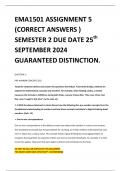EMA1501 ASSIGNMENT 5
(CORRECT ANSWERS )
th
SEMESTER 2 DUE DATE 25
SEPTEMBER 2024
GUARANTEED DISTINCTION.
QUESTION 1:
PRE-NUMBER CONCEPTS (25)
Read the statement below and answer the questions that follow. From birth already, children are
exposed to mathematical concepts and activities. For example, when feeding a baby, a mother
measures the formula in millilitres; during bath times, nursery rhymes like, “One, two, three, four
five- once I caught a fish alive” can be said, etc.
1.1 With the above statement in mind, discuss how the following five pre-number concepts form the
foundational understanding of numbers and how these concepts contribute to logical thinking about
numbers. (5x3= 15)
• One-to-one correspondence
One-to-one correspondence is the ability to match one object with another in a one-to-one manner.
This foundational concept lays the groundwork for counting, as it helps children understand that each
item or object has a unique value. This concept fosters logical thinking by encouraging children to
recognize that quantities are separate entities and can be counted individually. For example, if a child
counts five apples, they learn that each apple is distinct and contributes to the total.
, QUESTION 1:
PRE-NUMBER CONCEPTS (25)
Read the statement below and answer the questions that follow. From birth already, children are
exposed to mathematical concepts and activities. For example, when feeding a baby, a mother
measures the formula in millilitres; during bath times, nursery rhymes like, “One, two, three, four
five- once I caught a fish alive” can be said, etc.
1.1 With the above statement in mind, discuss how the following five pre-number concepts form the
foundational understanding of numbers and how these concepts contribute to logical thinking about
numbers. (5x3= 15)
• One-to-one correspondence
One-to-one correspondence is the ability to match one object with another in a one-to-one manner.
This foundational concept lays the groundwork for counting, as it helps children understand that each
item or object has a unique value. This concept fosters logical thinking by encouraging children to
recognize that quantities are separate entities and can be counted individually. For example, if a child
counts five apples, they learn that each apple is distinct and contributes to the total.
• Comparison
Comparison involves analyzing quantities to determine which is greater, smaller, or equal. This
foundational understanding empowers children to make decisions based on value, which is critical in
everyday situations. Logical thinking is enhanced as children learn to assess relationships between
numbers and develop insight into numerical values. For instance, comparing three oranges and two
apples allows children to understand that three is greater than two.
• Conservation
Conservation is the understanding that quantity remains the same despite changes in shape or
arrangement. This concept helps children grasp the idea that numbers and measurements are
consistent regardless of their representation. It promotes logical reasoning by allowing children to
develop abstract thinking about quantities, rather than relying solely on physical characteristics. For
example, if a child sees seven pennies spread out in a line and then bunched together, they can
understand that the number of pennies stays the same.
• Ordering
Ordering refers to arranging items or numbers in a specific sequence based on their value. This concept
lays the groundwork for understanding numerical order and fosters logical progression. Children learn to
compare and sequence numbers, enhancing their ability to identify patterns and relationships in
mathematics. An example includes arranging a set of blocks from smallest to largest, thus teaching
sequential understanding.




